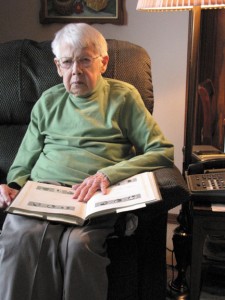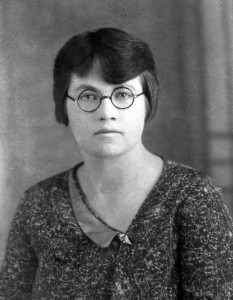Decades don’t dim a sharp memory of State for 103-year-old DeLong
Louise Franks had a lot of adjustments to make when she came to college. Most students do, especially when they come from a small town.
Franks grew up on a farm near Fulton, which is ten miles east of Mitchell. She was one of eight in her class. The town had a population of 214. That was in 1920.
When Franks came to South Dakota State College in 1925, Brookings had a population of 3,924. SDSC had an enrollment of 848—four times the population of her entire town. “It was different, much different, coming up here where there were so many people,†she recalled in a 2006 interview.
That was when Louise Franks DeLong was a mere 98. Today, DeLong is 103, will be 104 on October 8, and is SDSU’s oldest living graduate.
She lives at Brookhaven Estates, senior citizens apartments by the Brookings Hospital. By any standard, she could pass for twenty years younger. Her mind is sharp, her voice strong, her hearing clear, and she moves fluidly around her apartment with a walker.
“I’ve got a bad knee. That’s about my only problem,†DeLong says in a July interview, the day after her doctor gave her a clean bill of health.
Secret to long life
The keys to DeLong’s healthy, long age?
“First, it was a very simple, loving family life in Fulton. I’ve taken good care of myself. I have not smoked or drank. As a home ec major, I got that stressed on what to eat and what not to eat. I’ve followed through on that,†the Class of 1929 graduate says.
There is one other survivor from the 154-member Class of 1929. Mrs. Leslie W. Smith is 99. There are two from the Class of 1931.
Discovering modern conveniences
Among the adjustments DeLong made in moving from the farm to campus was electricity, indoor plumbing, and refrigeration.
“In the dorm [there was only one women’s dorm in those days], we had electricity, heat coming in, and water for bathrooms,†she recalls. “In the home I grew up in, we had lights that most people did not. We used carbon lights that you carried around.
“In our home, we had a bathroom, but we used it for a sewing room,†where Charity taught her daughter on a treadle sewing machine.
It was at State where DeLong had her first experience with a motorized sewing machine. “The main thing you had to learn was not to sew over your hand. I never had any accident like that,†says DeLong, who started sewing when she was eight.
Ironing also was done differently in the home ec classes overseen by Dean Edith Pierson and six other faculty members.
“We had a big ironer called a mangle. We all took turns using it. It surely must have been thirty-six inches wide, maybe wider. You stood in the front and fed the clothes into it,†DeLong said in her 2006 interview. A rotary drum replaced the traditional ironing board.
So after DeLong married, the mangle was on her must-have list. But as a housewife she found it impractical. Eventually it was donated to a museum.
Part of the home ec curriculum in DeLong’s days was to spend a quarter during the senior year in the home management house, which was at the location of the current University Police Department corner. Students cared for a child, planned meals, and did other domestic duties.
“We had a refrigerator [in the house], but at our home [in Fulton] we didn’t have a refrigerator for quite a while,†DeLong says.
SDSU before the Campanile
It’s hard to picture South Dakota State without the Campanile. But construction of the Campanile didn’t begin until DeLong’s senior year. “The Campanile was really special because it was tall and there by itself,†she recalls.
This was before Pugsley Union (1940). Lincoln Music Hall, then Lincoln Memorial Library, wasn’t dedicated until fall of her junior year.
That was State’s most historic building dedication. U.S. President Calvin Coolidge gave the message and laid the cornerstone for the adjacent Coolidge Sylvan Theatre September 10, 1927. The Coolidges had spent the summer in the Black Hills and were en route back to Washington, D.C.
DeLong also had been in the Black Hills that summer working as a nanny/housekeeper for a Brookings medical doctor, although she never saw the White House travelers.
Life as a nanny/housekeeper
During her last two years at State, DeLong lived in the dorm while working in this doctor’s household. During her first year, she received room and board in exchange for caring for the children of a faculty member. In her second year, she did the same for another family.
“That was one of the ways young women got to go to college,†DeLong explains.
Most people didn’t go to college then, certainly not women. But DeLong had a sister who was “really interested in education. She said we’re all going to college, so we did.†Her brother, Glenn, was three years older than DeLong and a year ahead of her at State. Helen was two years older than DeLong and attended Dakota Wesleyan. So the Franks had three in college at a time.
Elsie, who was five years younger than DeLong, attended a technical school.
‘Didn’t think we were poor’
Her parents were farmers with no college education, but they “went right along with†having their children in college. DeLong was aided by a scholarship that paid her tuition for all four years. Back then $50 would buy fifty five-pound bags of sugar and five, five-pound bags of flour, or a full year of tuition.
Growing up, DeLong says, “We just didn’t think we were poor. We had plenty of food, plenty of water, a way to get places. We had very few clothes, but we had what we needed.â€
Getting around meant using a one-seated buggy, a two-seated carriage, or the folks’ car—a Reo, a company founded by Ransom E. Olds that produced touring cars in the first three decades of the twentieth century. Its unique feature was a gas tank that fueled a separate motor for the lights.
However, “We didn’t go places at night, not very many,†DeLong recalls.
Still connected to college
Today, DeLong doesn’t go many places either, preferring the comforts of her apartment. But she does enjoy visitors, like two years ago when she was surprised on her birthday.
Ag Engineering Department Head Van Kelley and recipients of the DeLong Scholarship brought her flowers and a cake.
The scholarship was created in 1971, when her husband, Henry, retired as an ag engineering professor. The $2,500 scholarship was funded by Henry DeLong and his friends, colleagues, and former students. DeLong’s son, Max, continues to make contributions.
“All these [college] experiences have been very meaningful to me. . . . College affects your whole life—learning to work with other people; learning what we thought was important—our relation to our friends, activities in our church, and in our community.â€








